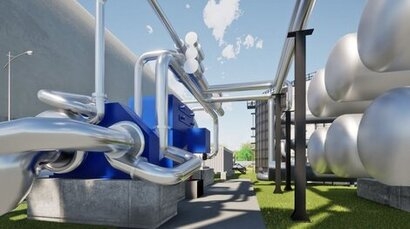
Energy Dome’s first commercial CO2 Battery storage facility is nearing completion in Sardinia, Italy and the company now anticipates seeing as many as 30 facilities being built over the next five years in Italy, Germany, the Middle East, and Africa.
These facilities will use Energy Dome’s non-flammable, non-toxic carbon dioxide-based energy storage solution to store and dispatch power. The companies anticipate the deployment of the first CO2 Batteries, including performance guarantees, starting in 2023, with Ansaldo Energia acting as EPC, based on the Front-End-Engineering-Design (FEED) developed by Energy Dome.
“Our agreement with Energy Dome is an important step in Ansaldo’s plans to expand our clean energy business with energy storage solutions to help power industry players get the most out of their solar, wind, and other renewable energy resources, while ensuring reliability” said Giuseppe Marino, CEO of Ansaldo Energia after signing the agreement. “We are pleased to include Energy Dome’s low-cost, long-duration energy storage solution in our suite of grid-scale clean energy solutions and look forward to deploying CO2 Batteries in Europe, the Middle East, and Africa.”
Energy Dome’s CO2 Battery technology does not involve scarce and environmentally challenging raw materials like lithium. Instead, it uses carbon dioxide and off-the-shelf components to charge and discharge power from 4 to 24 hours, enabling renewables to serve as fully-dispatchable daily energy resources. Energy Dome claims its CO2 Batteries can be deployed just about anywhere at less than half the cost of similar-sized lithium-ion battery storage facilities and have superior round-trip efficiency, with no performance degradation over a 25-year lifecycle.
Energy Dome’s CO2 Battery uses CO2 in a closed-loop charge/discharge cycle as a storage agent. Prior to charging, gaseous CO2 is kept in a large dome structure. During charging, electricity from the grid is used to compress the CO2 into liquid form, creating stored heat in the process. During discharge, the liquid CO2 is evaporated using the stored heat, expanded back into its gaseous form, and used to drive a turbine to generate electricity.
For additional information:

